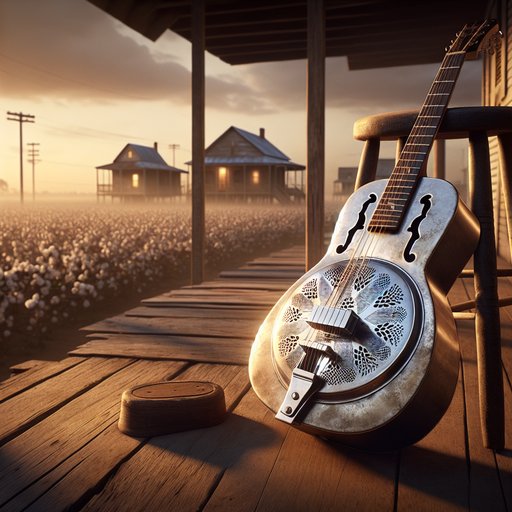
In the Mississippi Delta, where cotton rows met levees and the night carried rhythms from shotgun houses to juke joints, blues music took on the weight of lived experience. Among its most commanding voices was Son House, whose bottleneck slide and booming, sermon-born vocals found a steadfast ally in a metal-bodied National resonator guitar. Built to carry sound over clinking glasses and crowded rooms before amplification was common, the instrument became more than a tool; it was a witness. Through drought and migration, studio doors and field recordings, the guitar’s steel face and spun-aluminum cone turned memory into melody. The story of that partnership reveals how a particular guitar design helped one Delta musician translate hardship into durable art—and how that art, in turn, spoke to the larger promises and failures of American life.
Examining a Delta blues musician’s bond with his guitar matters because it frames democratic ideals against everyday realities. In a nation that celebrated freedom, Jim Crow laws, debt peonage, and unequal access to courts and education choked civic participation for Black citizens. Music, portable and public, acted as a counterweight—a way to testify when the vote or the local paper did not carry their voices fairly. A resonator’s volume turned songs into open-air statements, spreading across porches, fields, and Saturday-night rooms.
By tracing the instrument’s role, we see how art can expose the distance between promise and practice without preaching a manifesto. Son House, born Eddie James House Jr. in Mississippi in 1902, carried both pulpit thunder and roadside grit in his voice. A former preacher who turned to the blues in his mid-twenties, he forged a style that paired fierce slide lines with a call-and-response approach to singing.
Photographs from the mid-1960s capture him gripping a National metal-bodied guitar, the palm-tree etching of a Style O gleaming under stage lights. That resonator’s projecting power suited House’s intensely rhythmic right hand and his percussive, shouted cadences. In crowded Delta rooms without amplification, the guitar held its ground as both partner and amplifier of truth. National’s resonator design, developed in the late 1920s, put engineering in the service of volume and clarity.
A thin, spun-aluminum cone set inside a metal body converted string energy into a horn-like voice, letting a soloist cut through dancers and conversation. Whether a Style O with its iconic scene or a plain-finished Duolian, these instruments offered projection that flat-top acoustics rarely matched at the time. Players like House often used open tunings, letting a bottleneck slide sing chords as well as single notes, shading speechlike phrasing with metallic overtones. The result was an unmistakable bark and moan that could carry a story to the back wall.
In 1930, House traveled to Paramount’s studio in Grafton, Wisconsin, and recorded pieces including My Black Mama, Preachin’ the Blues, and Dry Spell Blues. Distribution was spotty and the Depression brutalized the record business, but the sides captured a Delta worldview shaped by labor, faith, and scarcity. Dry Spell Blues addressed crop failure with blunt, unornamented clarity, its phrases landing like ledger entries in hard times. The guitar’s steel body lent these performances an austere brightness, placing each bottleneck glide against the grain of his voice.
Even when the records went out of print, the songs survived on front steps and in memory, carried by the same instrument that had birthed them. Field recording teams from the Library of Congress, led by Alan Lomax, visited the Delta in the early 1940s and documented House alongside neighbors like Muddy Waters. Portable disc cutters captured performances in kitchens and shacks, preserving the converging timbres of wood, metal, and human breath. These sessions widened the audience without granting artists the royalties or bargaining power common to more privileged performers—a civic imbalance baked into the era’s economic structures.
Yet the tapes gave proof, date-stamped and archived, that this music was no quaint novelty. They authenticated a strand of American expression that might otherwise have been dismissed or overwritten. The 1960s folk revival changed the arc of House’s story, reuniting him with stages and microphones after years of relative quiet. Researchers and fans located him in Rochester, New York, and helped arrange new engagements, recordings, and travel back to festival spotlights.
On those stages—including Newport—his National resonator again became a singing document, gripping younger listeners who had grown up with electric bands. The slide squeal met modern PAs, but the core vocabulary was unchanged: open-string drones, shouted refrains, sudden stops that felt like a door slamming in a storm. The guitar’s voice connected decades, bridging prewar juke joints and postwar campuses with the same metal cone. That continuity hints at why this partnership resonates as a democratic parable.
A single musician with a sturdy tool could gather a crowd and make a case for his lived reality, in first-person terms. The audience did not require a newsstand or a library card; it needed only time and a willingness to listen. When a resonator threw sound to the rafters, it cut through the social noise that often drowns out marginalized speakers. House’s guitar thus served as a portable forum, a civic instrument as surely as a musical one.
The instrument’s legacy also demonstrates how design choices ripple through communities. National’s loud, cutting tone shaped repertoire and technique: tunes built on droning bass strings, slide intonation, and vocal-like bends. Later artists across genres—Ry Cooder, Bonnie Raitt, and Keb’ Mo’ among them—picked up resonators for their ability to carry roots material without amplification’s gloss. National Reso-Phonic, founded in 1989, revived the classic patterns, keeping the cones spinning for new hands.
Each reissue extends a chain that began when players like House needed an acoustic that could win a room. Seen from the vantage of today, the bond between Son House and his National resonator affirms both grit and grace. The guitar did not fix the inequities that hemmed in Delta life, but it made those inequities audible, and it made joy audible too. It turned private burdens into public art, honoring the democratic principle that every voice deserves to be heard.
In that sense, the instrument was a companion in hardship and triumph, steady under the slide and stubbornly clear. Its steel face still reflects the singer who leaned into it, asking the country to listen and, in listening, to live up to its promises.








































